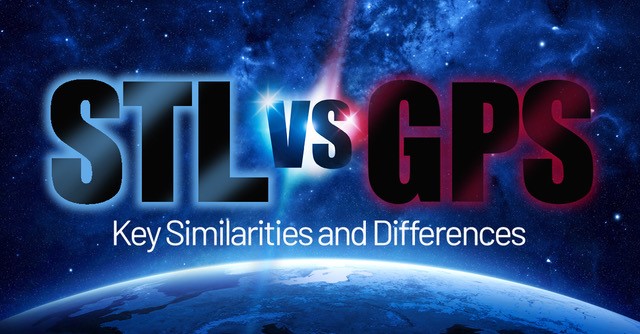There are several similarities between STL (Satellite Time and Location) and the Global Positioning System (GPS) or Global Navigation Satellite Systems (GNSS). All are satellite-based radio navigation systems, used for positioning, navigation, and timing (PNT).
- STL uses the Iridium® constellation in low Earth orbit (LEO)
- GPS uses satellites owned by the U.S. government and operated by the U.S. Space Force in mid Earth orbit (MEO)
- There are several different GNSS constellations operated by the European Union, Russia, and China, all in MEO.
Both STL and GPS require receivers to be integrated into user equipment and require antennas to receive their signals. As with most radio frequency (RF) signals, the specifics of the receiver and oscillator affect the quality of the STL and GPS signals.
There are several key differences between STL and GPS/GNSS, however.
1. Higher signal strength
GPS is a very weak signal and has been called a “whisper from space.” However, STL’s signal is only 485 miles from Earth, more than twelve thousand miles closer than GPS/GNSS satellites. This provides a signal approximately 1,000X stronger (30 dB) stronger than GPS/GNSS.
Like GPS, STL is in the L–band spectrum, which is more resilient to weather problems like rain fade. Because of its strong signal and use of L–band frequencies, STL can penetrate windows and walls to indoor locations where GPS is not available.
2. Resistant to manipulation
As GPS satellites move slowly around the Earth, they transmit predictable code patterns that make their signals vulnerable to manipulation or disruption. The Iridium satellites move faster and their smaller pattern of quickly changing spot beams are unpredictable. This, along with other state-of-the-art features, allows STL receivers to quickly detect and invalidate counterfeit (spoof-type) signals.
3. Requires only 1 satellite in view
There are 66 Iridium satellites that circle the Earth every 100 minutes (14 times per day.) They move so fast that their ranging angle can change up to 1 degree every 4 seconds, enabling a PNT solution use with just one satellite in view.
GPS has 24 satellites that circle the Earth every 12 hours (2 times per day.) They move so slowly that at least 4 satellites must be used for PNT.
This means that with STL you only need one satellite in view at a time to provide the same service as with four or five GPS satellites.

4. Purpose-built for PNT
While GPS started to help U.S. Department of Defense personnel and transportation units obtain their location, it was opened to the commercial sector in 1983. GPS has become integrated into society over the last 40 years, embedded in a variety of applications and technology. Because of widespread use of GPS/GNSS, many of its vulnerabilities have been exposed.
Satelles developed STL specifically as a PNT signal from the Iridium constellation to provide an alternative to GPS. STL has been commercially available since 2016 and is used in multiple critical infrastructure applications where GPS is unavailable, such as in high multipath, indoor, inaccessible, high interference or signal denied/spoofed environments.
5. Allows smaller antennas
STL requires a much smaller antenna—about the size of a small pepper shaker. STL’s antennas can be installed either indoors or outdoors. This, along with the smaller size, provides more flexibility, as they can be mounted unobtrusively and closer to where the PNT signal is needed, even indoors. GPS antennas are larger and only work outdoors, which can sometimes be prohibitive to their use.
STL as Primary or Backup
STL’s advantages in working in areas where GPS/GNSS does not, such as occluded environments and indoors, as well as the security benefits of STL, enable many organizations to rely on STL as a primary source of PNT to meet their requirements.
STL can also be integrated into equipment that relies on GPS today, which means STL can easily serve as a backup to GPS. This capability protects operations of PNT-dependent systems and critical infrastructure, such as 5G networks, enhancing survivability and resilience.
********
Interested in learning more about the capabilities and advantages of Iridium STL? Contact us to speak to an STL expert.
